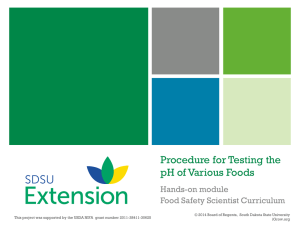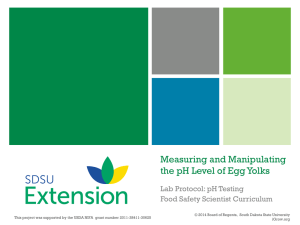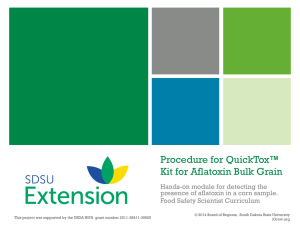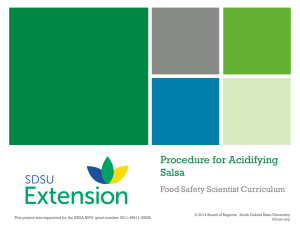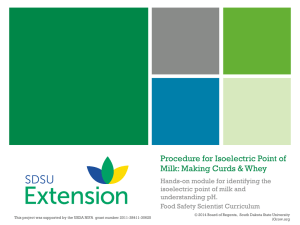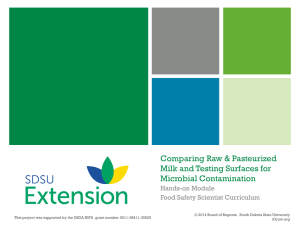Gram Staining Yogurt Sample or Milk (raw or pasteurized)
advertisement
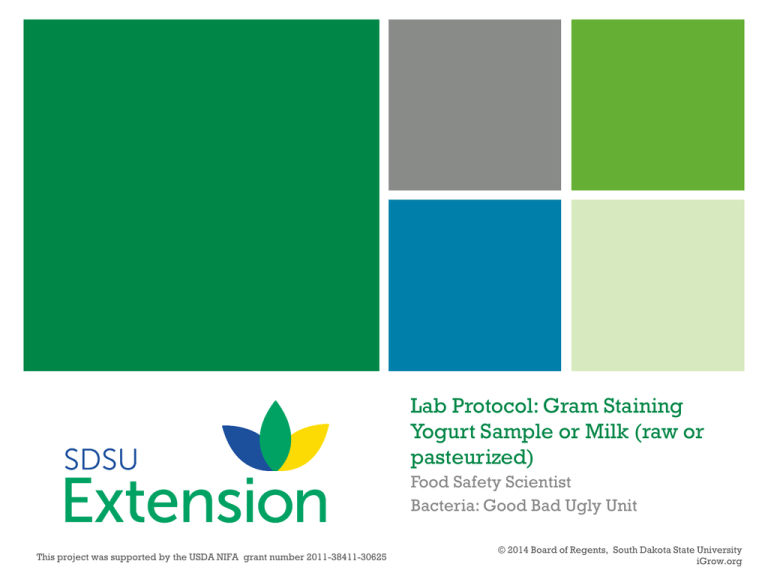
Lab Protocol: Gram Staining Yogurt Sample or Milk (raw or pasteurized) Food Safety Scientist Bacteria: Good Bad Ugly Unit This project was supported by the USDA NIFA grant number 2011-38411-30625 © 2014 Board of Regents, South Dakota State University iGrow.org Equipment Inoculating loop Bunsen Burner Glass microscope slide – clean Pipette (disposable) Clasp (close pin, or tongs) © 2014 Board of Regents, South Dakota State University iGrow.org Gram stain reagent set Crystal violet Gram’s iodine Decolorize reagent (95% alcohol) Safranin Microscope (preferably with oil immersion lens) iGrow.org Gram Staining – View Bacteria Gram staining process stains bacteria. The color can be observed under the microscope. Bacteria that stain a pink or reddish color are called Gram-negative. Bacteria that stain a purple color are called Gram-positive. © 2014 Board of Regents, South Dakota State University iGrow.org iGrow.org Procedure – Gram Staining Prepare work area: Wipe down the lab table with 70% ethanol solution. Turn on the gas valve and use the striker to light the Bunsen burner. © 2014 Board of Regents, South Dakota State University iGrow.org iGrow.org Procedure Preparing Slide: 1. Draw a circle in the center of a glass slide with a permanent marker. 2. The circle indicates where the small sample of yogurt will be placed. 3. Turn the slide over so the markings and the sample will be on the opposite sides. 4. Label the slide with date, sample source, and personal initial in the labeling area. © 2014 Board of Regents, South Dakota State University iGrow.org iGrow.org Procedure Sample dilution and inoculation: Transfer 1 milliliter (mL) of water (distilled or deionized) into a test tube. Thoroughly mix your sample (yogurt, milk, other food sample) with a spoon. Sterilize the inoculation loop in the flame of the Bunsen burner. (Hold it directly in the flame until it glows red hot.) © 2014 Board of Regents, South Dakota State University iGrow.org iGrow.org Procedure Sample dilution and inoculation continued With a cooled inoculating loop obtain a small sample of your food item. Transfer the sample sample into the previously measured water that is in the test tube. Cover the test tube with the screw cap and gently shake for 5 to 10 sec. to thoroughly mix the sample throughout the water. Sterilize the inoculation loop in the flame. © 2014 Board of Regents, South Dakota State University iGrow.org iGrow.org Procedure Transfer a small amount (two loops) of sample from the test tube to previously prepared slide. Tilt the slide to spread the drop out slightly, about the size of a penny. This picture has two circles, we are only doing one. © 2014 Board of Regents, South Dakota State University iGrow.org iGrow.org Procedure Heat fix the bacteria to the slide Hold the slide with a clasp (e.g. clothespin) and pass it over the flame of the Bunsen burner. Don’t place the slide directly in the flame -- this would burn the bacteria. © 2014 Board of Regents, South Dakota State University iGrow.org iGrow.org Procedure Staining 1. Cover the sample with Crystal Violet and allow it to set for 60 seconds. 2. Rinse with slowly running tap water. 3. Cover sample with Gram’s Iodine and let rest for 60 sec. Rinse with tap water. 4. Decolorize with decolorizing reagent 95% ethyl alcohol for 30 sec. Rinse with tap water. 5. Cover sample with Safranin – rest 60 sec. Rinse with water. © 2014 Board of Regents, South Dakota State University iGrow.org iGrow.org Procedure Dry the slide off by placing it between two sheets of highly absorbent bibulous paper, and gently press the paper down a few times. It is ready for observing under the microscope. © 2014 Board of Regents, South Dakota State University iGrow.org iGrow.org
